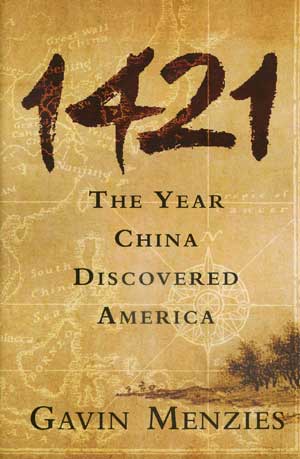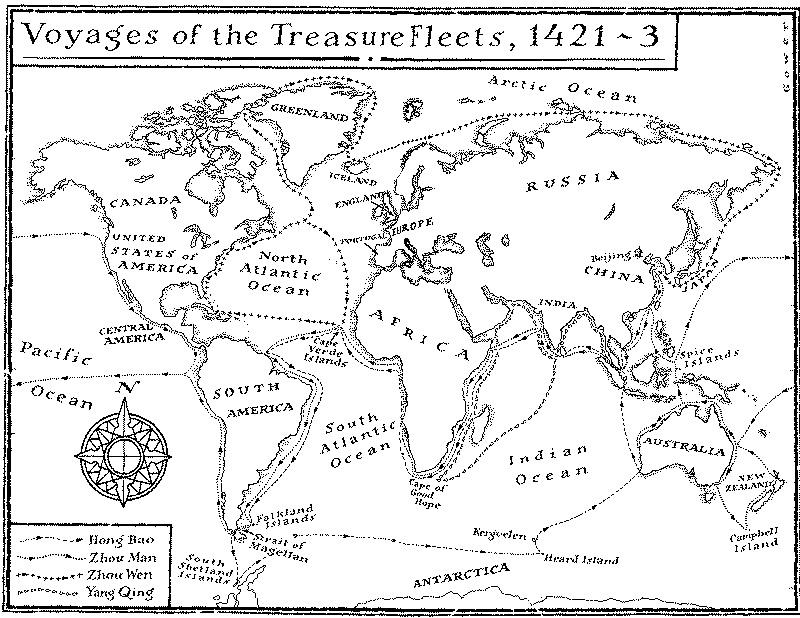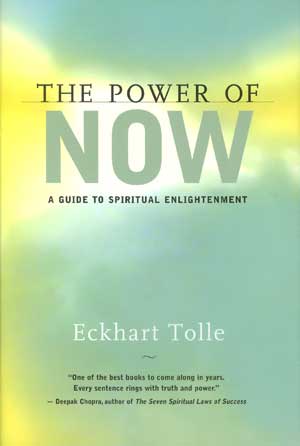
1421: The Year China Discovered America by Gavin Menzies, William Morrow/HarperCollins, New York, 2003; 552 pages, ISBN 0060537639, hardcover, $27.95. [An expanded paperback edition will soon be available.]
Ancient maps and charts, first-hand accounts of voyages of discovery, sunken ships, inscribed markers and relics -- these are among the data used to argue that the Chinese explored and mapped most of the world before Europeans set sail. A retired commander in the Royal Navy, Mr. Menzies' passion is old maps and charts, and anomalies he found in pre-Columbian European maps sparked his research. Written like a detective story, the book attempts to reconstruct the voyage undertaken between 1421 and 1423 by an immense Chinese fleet under Admiral Zheng He, with capital treasure ships 480 feet long and 180 feet wide. His mission in part was to travel to "the end of the earth to collect tribute from the barbarians beyond the seas" (p. 75) and bring them into the Chinese tribute system, and to prospect for minerals, search for useful plants, take astronomical observations, make accurate maps, and determine a way to navigate in the southern hemisphere. 1421 sets out the evidence for the author's reconstruction of the course of this sixth and last great voyage.

How could such a momentous event have been forgotten? Over several centuries the Chinese had built up a large military and trading fleet, and by 1400 were the dominant economic, political, scientific, and maritime power in the lands around the Indian Ocean. Emperor Zhu Di, on taking power in 1402, began a series of formidable projects. He moved the capital from Nanjing to Beijing, enlarged the Grand Canal to the new capital, built the Forbidden City, repaired the Great Wall, founded a foreign language academy, summoned 2,180 scholars to compile a 4,000-volume encyclopedia to preserve all known literature and knowledge, and initiated a tremendous increase in shipbuilding so as to recreate a trading empire on par with that of the Tang dynasty 500 years before. On Chinese New Year in 1421 his new capital was inaugurated with international pomp, including envoys from 28 nations and the son and grandson of Tamerlane. But within two years Zhu Di had died a broken man, the country reeling under the economic and social cost of his ambitious programs. Led by the mandarins, his son and grandson repudiated and reversed his policies, and China entered a period of isolationism and xenophobia lasting for centuries. Overseas trade and travel were banned, at one point learning a foreign language or teaching foreigners Chinese was prohibited, and in 1644 all records of the voyages of Zheng He were burnt by the Minister of War as "deceitful exaggerations of bizarre things far removed from the testimony of people's eyes and ears." As Mr. Menzies says, their memory was "expunged so completely over the succeeding decades that they might never have existed" (pp. 55, 56). The one remaining monument to Zheng He, a carved stone overlooking the Yangtze estuary, states:
The emperor . . . has ordered us and others at the head of several tens of thousands of officers and imperial troops to journey in more than a hundred ships . . . to treat distant people with kindness . . . We have gone to the western regions . . . altogether more than three thousand countries large and small. We have traversed more than a hundred thousand li [forty thousand nautical miles] of immense water spaces. -- p. 400
Most of the book details evidence and arguments for pre-Columbian Chinese exploration of North and South America, Australia, the Pacific, West Africa, and the area around Greenland, Iceland, and northern Siberia, the author concentrating on the voyages of 1421. Several 15th- and 16th-century European maps, shown in beautiful color reproductions, depict lands not yet "discovered" by Europeans. The 1428 world map, as well as subsequent maps held mainly by the
Portuguese, also showed the world's major rivers long before the first European set sail. Of particular interest are accounts of the European explorers which mention their use of these maps. The chronicler on the first European voyage around the tip of Africa in 1482 remarked: "This is the Cape drawn on Fra Mauro's planisphere of 1459" (p. 436). When Magellan's men threatened mutiny on entering the straits that now bear his name, his chronicler reports that "The Captain General said there was another Strait which led out [to the Pacific] saying he knew it well and had seen it in a marine chart of the King of Portugal," and states further that he later showed this chart to a Pacific ruler (pp. 436-7). In the 1770s James Cook also had access to some of these maps, one from the Admiralty. After his ship was damaged on a reef off Australia, as the first European in those waters he sailed straight to the only port in 1,000 miles of coastline, and wrote: "This harbour will do excellently for our purposes although it is not as large as I had been told" (p. 437). When on his return he claimed "to have discovered Australia, the head of the Map Department at the British Admiralty, Captain Dalrymple, wrote a furious protest" (p. 388). Thus the first Europeans not only knew they were not discovering "new" lands, but they had sailed there precisely because accurate maps already in their possession showed the routes and destinations.

Chinese voyages of 1421-1423 as reconstructed by Mr. Menzies
Mr. Menzies brings out evidence for longstanding contact among various continents, concentrating on the Chinese component. American turkeys had reached Turkey on the Silk Road before 1492, the chickens found in Central and South America hail from Asia, the first Europeans to arrive in Peru found horses, and at least forty pre-Columbian drawings of horses have been found in central North America. The first Europeans also found
fields of rice -- a crop foreign to the Americas -- in Mexico and Brazil; cotton with chromosomes common to West Africa grew in the Revillegado Islands; and coconuts brought from the South Pacific grew in Puerto Rico and right across the Isthmus of Darien to the Pacific coast, sugar cane in plantations besides the Amazon and Orinoco Rivers, and bananas beside tributaries of the Amazon, where there were also Chinese root crops. Tobacco, sweet potatoes and maize from the same area were exported to south-east Asia and the Pacific. All of these animals and plants confirm that there were seaborne voyages to and from the Americas prior to Columbus. -- pp. 412-13
Chinese presence in the Americas is old news to many scholars, for there are "more than a thousand books providing overwhelming evidence of pre-Columbian Chinese journeys to the Americas." But as an expert in the field, George F. Carter, has remarked, "Sinologists and Asiatic art historians are normally struck by the overwhelming, all-pervasive evidence of Chinese influence in Amerindian civilization. Seemingly the Americanists are not aware of the Chinese literature suggesting not only discovery but colonization of America" (p. 232). Indeed, as Mr. Menzies states, "A mountain of evidence -- wrecks, blood groups, architecture, painting, customs, linguistics, clothes, technology, artifacts, dye-stuffs, plants and animals transferred between China and South America -- points to a pervasive Chinese influence the length of the Pacific coast of Central and South America, and inland" (p. 226).
1421
brings facts and anomalies to popular attention in an engaging and absorbing way. It adds to the evidence of such researchers as Thor Hyerdahl, Barry Fell (who in America B.C. and subsequent research detailed evidence of Celtic, Phoenician, and ancient Egyptian presence in North America), and those presenting evidence of an ancient African presence in the Caribbean. Mainstream American and European scholarship unfortunately still holds tenaciously to enthnocentric ideas -- for example, that no culture could cross the oceans to colonize and trade if Europeans could not -- and to theories established long before current evidence was available. Evidence continues to accumulate rapidly in this field, however, and we can look forward to exciting and perhaps unexpected developments. -- Sarah Belle DoughertyThe Power of Now: A Guide to Spiritual Enlightenment by Eckhart Tolle, New World Library, Novato, CA, 1999; 193 pages, ISBN 1577311523, hardcover, $22.95.
This practical guide provides understanding and techniques to help people live increasingly in the "Now." It points out forcefully that we are not our ever-changing thoughts and feelings, although we generally identify ourselves with them. The full extent of our consciousness is much deeper, but in order to experience these further reaches of our being, we must be able to control our mind and stop our habitual thinking when we wish to and have no need for it. The ego or limited sense of self forms itself largely of thoughts, feelings, and judgments about a conjectural past and future, and avoids the present moment when all life is experienced. In fact, there is nothing other than the present, though we often fill it with expectations, worries, imaginings, and feelings about things that are not presently going on. The author holds that our "problems" are illusions created by this egoic, time-bound mind:
Focus your attention on the Now and tell me what problem you have at this moment.
Ò
I am not getting any answer because it is impossible to have a problem when your attention is fully in the Now. A situation that needs to be either dealt with or accepted -- yes. Why make it into a problem? . . . "Problem" means that you are dwellling on a situation mentally without there being a true intention or possibility of taking action now and that you are unconsciously making it part of your sense of self. You become so overwhelmed by your life situation that you lose your sense of life, of Being. Or you are carrying in your mind the insane burden of a hundred things that you will or may have to do in the future instead of focusing your attention on the one thing that you can do now. -- pp. 53-4

When we are able to stay in the here and now, we spontaneously come in touch with our true self or wider consciousness, a process which is very threatening to the false self or ego. In addressing the comment that the "present moment is sometimes unacceptable, unpleasant, or awful," the author responds:
It is as it is. Observe how the mind labels it and how this labeling process, this continuous sitting in judgment, creates pain and unhappiness. By watching the mechanics of the mind, you step out of its resistance patterns, and you can then allow the present moment to be. This will give you a taste of the state of inner freedom from external conditions, the state of true inner peace. Then see what happens, and take action if necessary or possible.
Accept -- then act. Whatever the present moment contains, accept it as if you had chosen it. Always work with it, not against it. Make it your friend and ally, not your enemy. This will miraculously transform your whole life. -- p. 29
Not written from any theological standpoint, though occasionally using examples from the world's religions, the book seeks to restate the "one timeless spiritual teaching, the essence of all religions" (p. 6). Based on the author's experience and the comments and questions of his students, it is a personal and fresh restatement, and readers may find helpful ideas and approaches to consider or apply. -- Sarah Belle Dougherty
(From Sunrise magazine, October/November 2003; copyright © 2003 Theosophical University Press)